Fusiliers were officially to wear a white shako cord, but it appears that these were seldom worn on campaign. The shako was usually covered with tan, grey, or black cloth to protect its ornaments on campaign. Once soldiers took the field they generally shed their stockings and gaiters in favor of more practical overalls or trousers. Many battalions would have worn overcoats on the field, both for warmth and protection for sabre cuts. Trousers and greatcoats could be of varying colors, with tan, white, brown, and grey the most usual. Fusiliers wore only one white leather belt to support the cartridge box. Some very few regiments may have carried the sabre-briqeut with its white belt, but they were definitely the exception.
The uniform of the grenadier companies included red cuffs, red collars, red epaulettes, red shako cords, red shako chevrons, and a red shako plume. Some grenadiers wore the bearskin, but these were difficult and expensive to replace. The voltiguers were uniformed in more variety, but the basic uniform included hunter green cuffs, hunter green or yellow collar, hunter green epaulettes with yellow crescent, hunter green or yellow shako cords, yellow shako chevrons, and a yellow plume tipped with hunter green. All elite company men wore crossbelts to support their cartridge box and sabre-briqeut. The shako cords might disappear on campaign, but most of the other niceties were kept.
It took some time for these changes to be effected. As late as 1809 there was a mixture of white and blue jackets and bicornes and shakos.
There are three sets of fusiliers available for this period in varying degrees of quality, but none for the elite companies.
Esci and Italeri both produce beautiful sets, with well-porportioned fusiliers. Although the two are equally well sculpted - I suspect by the same person - the Italeri set has by far the better poses. The Esci poses are very static and not at all good for miniatures gaming. The Italeri Frenchmen look better employed en masse, with more useful shooting and advancing poses. Despite the slight difference in scale (the Esci figures are a little bigger), men from the two sets can be mixed together in the same units. The problem with both of these is that the lapelled uniforms do not match the short turnbacks. No French infantry ever wore this uniform! Hopefully no one will notice.
Another problem is that the figures in each of these sets wear crossbelts (the second belt is for the saber which elite companies carried), indicating that they belong to a grenadier or voltigeur company, but lack the epaulettes, shako cords, and shako plumes which further distinguished these men. Non-commissioned officers also carried the sabre, which leaves us with boxes of line NCOs with no men to lead. These are suitable for the few regiments which wore the sabre-briqeut, but none others.
The HaT Young Guard set is much better, both in terms of economy of
painting (the overcoats are much easier to mass-paint than the jackets)
and historical accuracy.
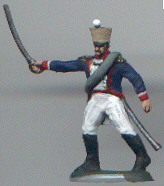 |
 |
 |
 |
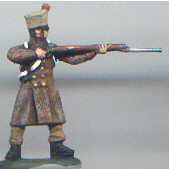 |
 |
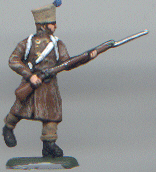 |
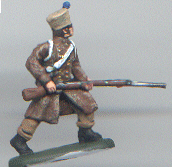 |
HaT Industrie's French Young
Guard wears the line infantry uniform in greatcoats and covered shako,
and is historically accurate. They can be painted to represent any
French line fusiliers from the period 1806-1815. Since many units
would not have worn eppaulettes on the greatcoat, these can also be used
for voltiguers and grenadiers. The figures are as easy to paint as
WWII figures, and whole battalions can be raised very quickly. The
pose selection is very good, with lots of nice marching and advancing figures.
I like my army to appear in the campaign dress it would have actually worn
on the wet and muddy field, so these figures are ideal for me. If
you like a more parade-ground appearance (as many do) these figures are
not for you. The officer can be used for any French infantry or artillery
of the 1812-5 period. Pictured are all eight poses included in the
set.
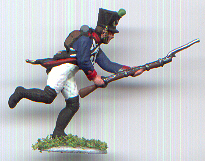 |
 |
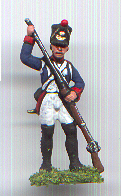 |
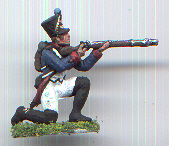 |
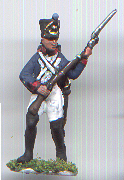 |
 |
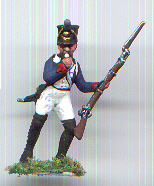 |
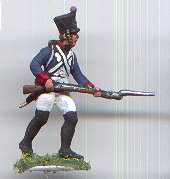 |
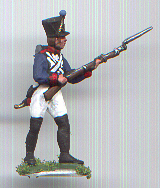 |
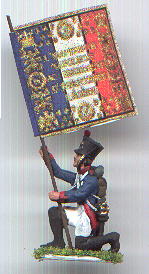 |
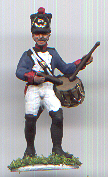 |
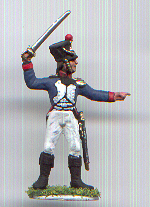 |
|
|
|
|
 |
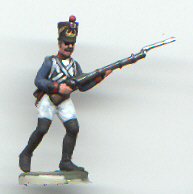 |
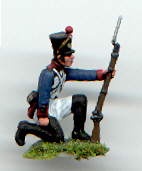 |
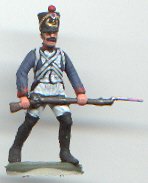 |
|
|
|
Haythornthwaite, Philip and Bryan Fosten. Men at Arms Series 141: Napoleon's Line Infantry. London; Osprey Publishing, Ltd., 1983.
Haythornthwaite, Philip and Michael Chappell. Uniforms of the Peninsular Wars: 1807-1814. Hong Kong; Arms and Armour Press, 1995.
Haythornthwaite, Philip and Michael Chappell. Uniforms of Napoleon's Russian Campaign. Hong Kong; Arms and Armour Press, 1995.
Last updated on 05 April, 2002
This page created using Netscape
Composer